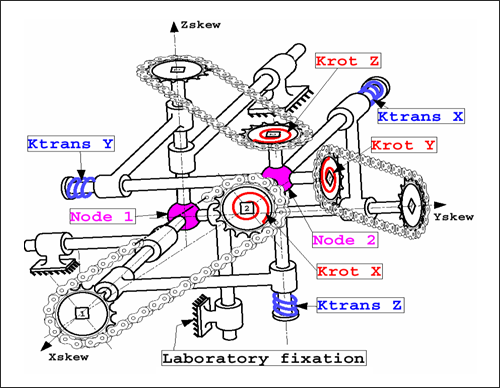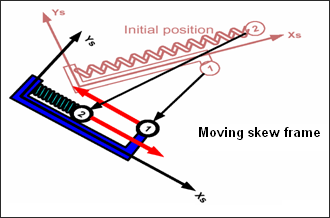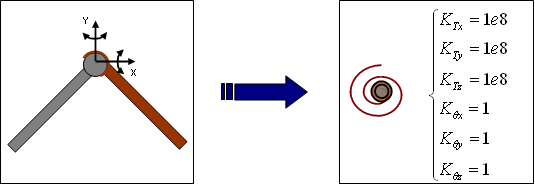General Type (/PROP/SPR_GENE) |

|

|

|

|
|
General Type (/PROP/SPR_GENE) |

|

|

|

|
Spring type 8 is a six degrees of freedom spring: three translations and three rotations. Each degree of freedom is independent from the other, and is associated with a specific stiffness (see Stiffness for more details). To compute the critical time step, the minimum over all degrees of freedom is kept using the following formula:
![]()
Where, l is the moment of inertia and ![]() is the related stiffness.
is the related stiffness.
The local coordinate system is not associated with the nodes positions, if no local skew is specified (moving or fixed), the global coordinate system is used.
To understand the physical behavior of this mathematical spring, imagine that the two nodes of the spring are chained together. Therefore, only the relative translation/rotation between nodes can be considered as independent degrees of freedom. Below is a schematic illustration.

Fig. 3.4: Spring type 8
|

Fig. 3.5: Deformation in local X-direction
It can also be noted that the global force equilibrium is fully respected but not the global moment equilibrium. Therefore, the spring is connected to the laboratory which applies the missing moments. It is generally recommended to use spring type 8, only if one node is fixed in all directions or if two nodes are coincident (if the two nodes are coincident, the translational stiffness' has to be large enough to ensure that the nodes remain near coincident during the simulation). Doing so, the global moment equilibrium is respected.
|
Spring type 8 is generally used to model connection between two parts. For example, pivot points in the steering system are modeled with spring type 8. To properly model this type of connection, translational degrees of freedom must be blocked through the use of rather high stiffness' and all rotational degrees of freedom must be set free. Below is an example of such a connection, note that the stiffness values are arbitrary and that they should be adjusted according to a relevant unit system.
|

Fig. 3.6: Use of spring type 8 in modeling of hinge
For further information, refer to the RADIOSS Theory Manual.